“Please Sir, I Want Some More...”: The Reality of Workhouse Dietaries
This is a special guest blog by Peter Higginbotham, a freelance author and historian who is also a member of the Editorial Board for AM's resource, Poverty, Philanthropy and Social Conditions in Victorian Britain.
Oliver Twist’s words in the dining hall of the Mudfog workhouse are one of the best-known literary quotations in the English language. As a result, we all know exactly what workhouse inmates had to eat. Gruel. But how accurate was Dickens’ portrayal? AM's new resource Poverty, Philanthropy and Social Conditions in Victorian Britain offers some very interesting insights.
Although Oliver Twist began publication in 1837, three years after the passing of the Poor Law Amendment Act, Oliver’s workhouse is clearly a pre-1834 parish establishment. Parish workhouses varied in matters such as the diet they imposed on their inmates but the weekly menu in 1742 at St Margaret’s, Westminster, is fairly typical:
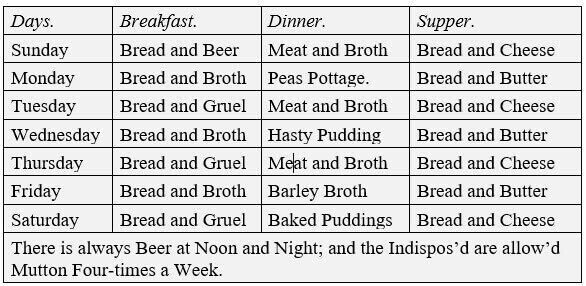
1742 Dietary at St Margaret’s Workhouse Westminster. [1]
Some parish workhouses were more generous in the fare they offered. At Brighton, in 1834, inmates were provided with three meals a day with no limits on quantity. Men received two pints of beer a day, children one pint, and women a pint of beer and a pint of tea. There were six meat dinners in the week and the inmates were served at table with the governor carving for the men and boys, and the matron for the women and girls.[2]
The 1834 Act aimed to make the workhouse a deterrent institution, with strict discipline, hard work and a plain diet. A typical dietary, as featured below from the papers of Assistant Poor Law Commissioner Richard Earle, digitised for Poverty, Philanthropy and Social Conditions in Victorian Britain, offered an unvarying menu of bread and gruel for breakfast, and bread and cheese for supper. Midday dinner was also bread and cheese on three days a week, bread and soup on Thursdays, and meat and vegetables on the other three days.
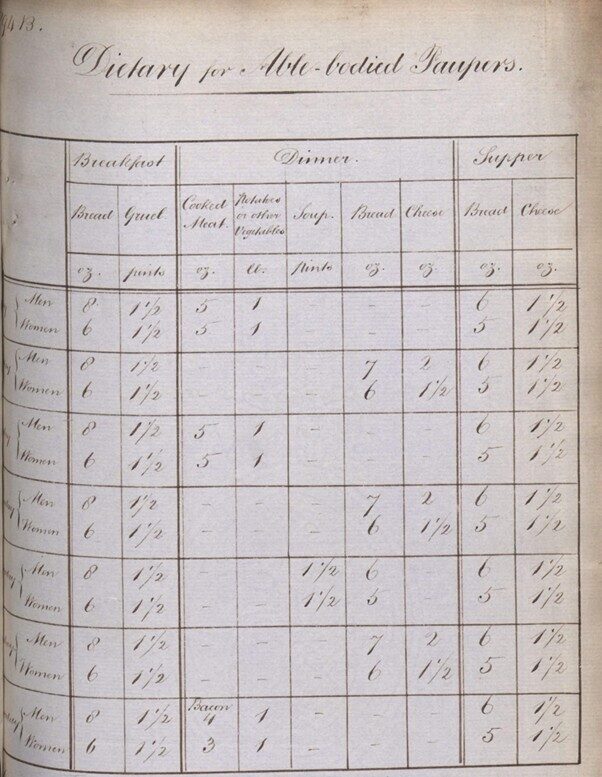
Richard Earle, correspondence and papers relating to unions in the West Midlands District (including Stafford and Warwick), 1835-1838 © Images including crown copyright images reproduced by courtesy of The National Archives, London, England. www.nationalarchives.gov.uk.
In the 1860s, Dr Edward Smith, a much-neglected pinoeer in history of nutrition and physiology, made considerable effort to improve the nutritional quality of workhouse food. His 1866 survey for the Poor Law Board in his role as Medical Officer, for example, found that the amount of oatmeal used in making a pint of gruel ranged from a miserly 0.75 ounces at Easingwold to a glutinous 4 ounces at Scarborough.[3] The Poverty, Philanthropy and Social Conditions in Victorian Britain collection provides an insight into Smith's pinoeering work through his correspondence and papers (1865-1875).

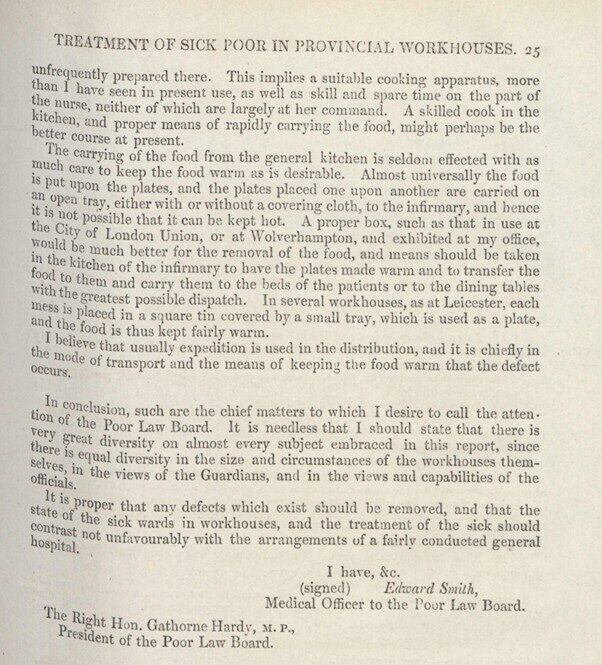
Smith’s 1867 Report on Existing Arrangements for the Treatment of the Sick in Provincial Workhouses, from Edward Smith, correspondence and papers relating to the Eastern District (including Cambridge and Norfolk) and North Midland District, 1865-1875 © Images including crown copyright images reproduced by courtesy of The National Archives, London, England. www.nationalarchives.gov.uk.
The food provided to sick inmates came under the spotlight in Smith’s detailed reports of conditions at forty-eight workhouses. He was concerned with matters such as how food was kept warm while transported to the inmates, and the plates and utensils used by its consumers.
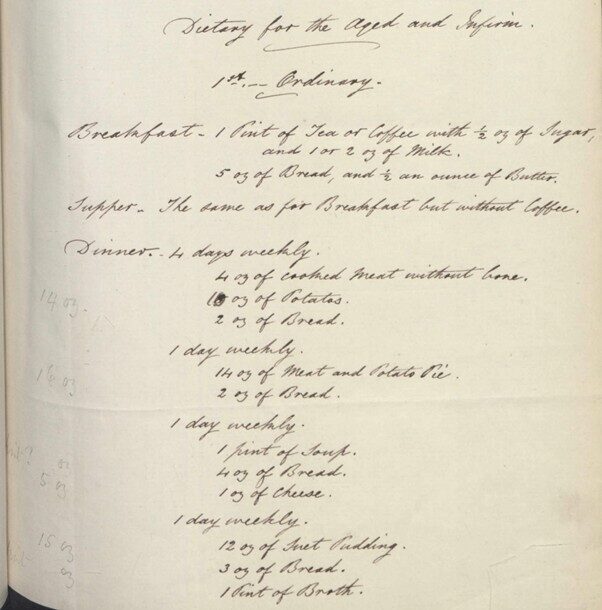
One of Edward Smith’s new dietary proposals, from Edward Smith, correspondence and papers relating to the Eastern District (including Cambridge and Norfolk) and North Midland District, 1865-1875 © Images including crown copyright images reproduced by courtesy of The National Archives, London, England. www.nationalarchives.gov.uk.
Smith’s numerous proposals for improvements in workhouse nutrition were issued to Boards of Guardians as recommendations rather than orders so, unfortunately, were largely ignored.
By the 1890s, partly reflecting the growing number of female guardians, individual unions were increasingly taking unilateral action to make changes to the existing restrictions on diets as revealed by Grace Finlay's paper presented at an 1897 conference of women guardians, also featured in Poverty, Philanthropy and Social Conditions in Victorian Britain.
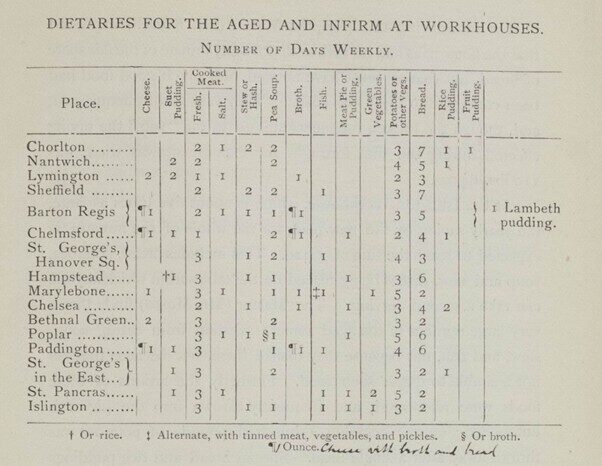
Grace Finlay’s 1897 paper ‘On Workhouse Dietaries’ © Images reproduced courtesy of Senate House Library, University of London
A major overhaul of workhouse diets finally came in 1900. Each institution could then compile its own weekly menu from a list of about fifty approved dishes. An accompanying cookbook was produced to try and ensure standardisation of the food. The book contained such undreamed-of treats as Irish stew, shepherd’s pie, pasties, cake and roly-poly pudding.[4]
As for Oliver Twist, there never was, as far as I have discovered, a workhouse where the inmates – even just the children – existed almost entirely on gruel.
The Family Welfare Association library was gifted to Senate House Library, University of London by the charity as it operates today: Family Action (www.family-action.org.uk/). The Library and publisher are grateful to Family Action for their donation of the material, and for this opportunity to take the story of their pioneering charitable work to a global audience of researchers.
External References:
[1] Anonymous, 1742, A New and Compleat Survey of London, by a Citizen, and Native of London, p. 1143.
[2] Parliamentary Papers: Report into the Administration and Practical Operation of the Poor Laws: Appendix A, Part I, p.532A.
[3] Smith, E., 1866, Dietaries for the Inmates of Workhouses, pp. 303-4
[4] Higginbotham, P., 2008, The Workhouse Cookbook, p. 181.
Recent posts

The blog highlights American Committee on Africa, module II's rich documentation of anti-apartheid activism, focusing on the National Peace Accord, global solidarity, and student-led divestment campaigns. It explores the pivotal role of universities, protests, and public education in pressuring institutions to divest from apartheid, shaping global attitudes toward social justice and reform.

This blog examines how primary sources can be used to trace the impact of young voices on society, particularly during pivotal voting reforms in the UK and the US. Explore materials that reveal insights into youth activism, intergenerational gaps, and societal perceptions, highlighting their interdisciplinary value for studying youth culture, activism, and girlhood across history.
